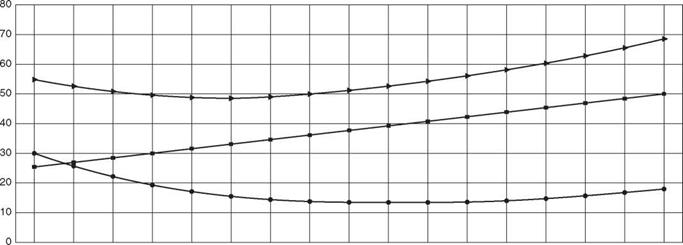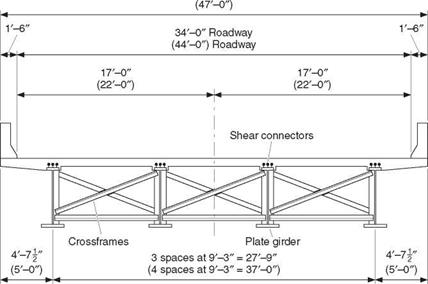DECK DRAINAGE
Adequate drainage of the deck is important for safe operation during rainstorms, to prevent accumulation of rainwater or snowmelt that could freeze and cause skidding, and to prolong the life of the deck by removing standing water, which would otherwise contribute the water element necessary for corrosion. Transverse drainage of the deck should be provided by cross-slope whereas zero gradients and sag curves on bridges should be avoided.
Design of the drainage system is frequently one of the last items listed in the scope of services for a bridge design project. This implies a secondary importance, but that is certainly not the case. On the contrary, the South Carolina DOT requires that scuppers of adequate size and spacing for high-intensity rainfall be shown in the preliminary bridge plan view. The DOT reviewers check the scupper design as part of the preliminary design review. This is the stage when deck drains should be designed. At this stage changes as major as span layout revision can be made with relative ease to ensure adequate drainage, including provision for longitudinal conductors with acceptable slopes, and downspouts, if necessary.
Scupper Size and Shape. Bridge scuppers are unlike roadway drains, which can have large grates through which the storm water flows and drops into a large sump and then is conducted away by transverse or longitudinal drain pipes. Bridge scupper outlet pipes generally must be small circular, square, or rectangular pipes, and so any enlargement of the scupper surface opening must be limited to prevent debris from being trapped, clogging the scupper and making it ineffective. A minimum surface opening larger than the diameter of a beverage can is desirable and should be maintained to the outlet end. Some states require the use of bicycle-safe grates on bridges where bicycle traffic is allowed. Bicycle-safe grates have smaller individual openings that would prevent catching of the tire but should provide the same overall opening area required by the drainage design. An open 4-in – (100-mm) or 6-in-diameter (150-mm) pipe meets this requirement and is economical compared with scuppers having large fabricated boxes with crossbars, so that more of them can be provided at the same cost. Where the discharge can be corrosive, such as where deicing salts are used, the pipe should extend below the bottom of an adjacent beam to prevent the discharge from being blown onto the beam. This is especially important on weathering steel bridges, and is also important on painted steel and concrete bridges. In areas that do not experience freezing, a formed opening in the deck may be acceptable, or the pipe need not extend below the beam. In this case one can expect a stain to develop on the beam onto which the discharge is blown. Some states prohibit drainage directly onto unpaved embankments or natural ground where erosion could undermine structural elements, or onto any traveled way, either vehicular or pedestrian.
Deck Drainage Criteria. Deck drainage design is based on preventing storm water from spreading in the gutter more than an acceptable amount during a rainfall of a given intensity. For example, the maximum permissible spread may be the width of the shoulder, or the spread may be permitted to extend across half of the outside lane of a multilane directional roadway. One source of such drainage design criteria is the U. S. Department of Transportation document “Drainage of Highway Pavements,” Hydraulic Engineering Circular 12 (HEC 12).
Scupper Design Procedure. After the size of the scupper opening is established, the spacing may be determined. It’s a common practice to locate the scuppers just ahead of the bridge joints to collect most of the runoff water therefore reducing the possibility of rainwater leaking through damaged bridge joints and causing deterioration in superstructure and substructure. In bridges with longer spans, rather than try to directly determine the spacing, it may be easier to select a trial spacing and then check the adequacy of that spacing by using a hydraulic analysis method acceptable to the client. The use of computer programs greatly expedites this task.
Collection of Runoff. In areas such as reservoirs and sensitive wetlands, it may be necessary to provide a collector system and temporarily detain the first half inch or inch of rainfall from each storm. It is assumed that the initial rainwater that falls at the beginning of a rainstorm will contain most of the roadway pollutants that can be carried away with the runoff. The objective is to prevent these pollutants, especially petrochemicals (crankcase drippings, fuel spills, etc.), from polluting the area under the bridge. The collected storm water is treated and then discharged. In some cases this protection is extended to the roadway as well.










